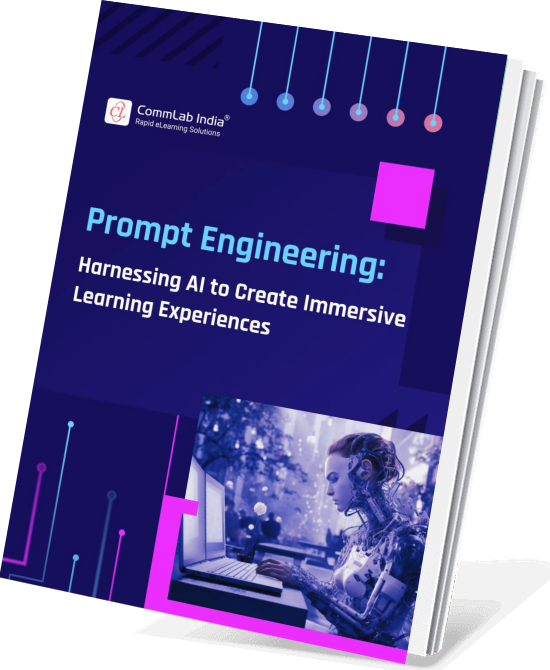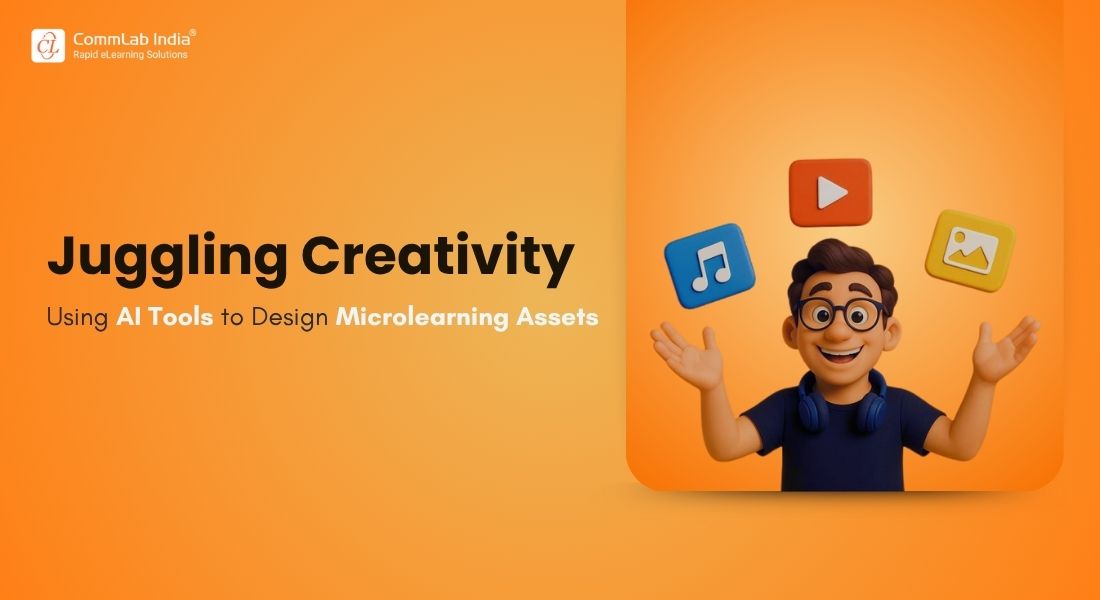Microlearning & AI: A Complete Guide [Design Tips + Best AI Tools Included]
![Microlearning & AI: A Complete Guide [Design Tips + Best AI Tools Included] Microlearning & AI: A Complete Guide [Design Tips + Best AI Tools Included]](https://blog.commlabindia.com/hubfs/blogs/ai-tools-create-microlearning-courses.jpg)
In today’s fast-paced world, where information overload is the norm, microlearning has emerged as an effective solution to deliver bite-sized and focused learning experiences. Microlearning breaks down complex topics into clear and concise modules of information, making it easier for learners to grasp and retain information. However, the design and delivery of effective microlearning content can be a daunting task. Fortunately, advancements in artificial intelligence (AI) have opened new possibilities for creating high-impact, engaging microlearning experiences, making it easier to keep up with the learning needs of the modern workforce. Let’s understand how AI can help you curate amazing microlearning modules and explore the top 10 AI tools for creating effective microlearning courses.
→ Download Now: Prompt Engineering for L&D Professionals!
Table of Contents
- What is Microlearning?
- Why is Microlearning Important for Corporate Training?
- Why Leverage AI for Impactful Microlearning?
- How to Create AI-Powered Microlearning Courses?
- What Are the Top 10 AI Tools for Creating Effective Microlearning Courses?
- What Are the Tips for Effective AI-Powered Microlearning in Corporate Training?
- What Are the Challenges and Ethical Considerations in AI-Powered Microlearning Implementation?
- What Are the Future Trends in AI-Enhanced Microlearning for Corporate Training?
What is Microlearning?
Microlearning is a training approach that involves breaking down complex information into small, easily digestible modules. These modules can take various forms, including videos, quizzes, infographics, podcasts, interactive eBooks, short articles, etc.
Why is Microlearning Important for Corporate Training?
Microlearning is an effective method in corporate training for several reasons. Some of the important reasons are listed below:

Now let’s take a closer look at the benefits of microlearning in corporate training.
1. Accessibility: Employees can access training content anytime.
2. Better Learner Engagement: Short content keeps learners engaged.
3. Knowledge Retention: Microlearning helps reinforce key concepts for better retention and application.
4. Flexibility: Microlearning modules can be easily integrated into the busy routines of employees.
5. Adaptability: Bite-sized nuggets can be curated to specific learning objectives, thereby ensuring relevance and conciseness.
While microlearning for corporate training works wonders, the advent of Artificial Intelligence (AI) holds immense potential to multifold the benefits of microlearning.

Prompt Engineering — Harnessing AI to Create Immersive Learning Experiences
Learn the Art of Crafting Effective Prompts and Get Desired Outcomes
- What is Prompt Engineering?
- Why is Prompt Engineering Important?
- How to Craft Effective Prompts?
- And More!
Why Leverage AI for Impactful Microlearning?
Reasons to Leverage AI for High-Impact Microlearning
Here are some impressive ones:
- Personalization for Maximum Engagement
- Immersive and Interactive Learning Experiences
- Effective Content Creation and Recommendation
- Leveraging Gamification and Learning Analytics
- Enhanced Training with Data Analysis
Now let’s explore in detail why AI tools should be leveraged to design and deliver effective microlearning content.
Personalization for Maximum Engagement
AI-powered algorithms have the remarkable ability to analyze vast amounts of learner data, allowing for personalized learning experiences in microlearning. By understanding individual learner preferences, performance, and learning styles, AI tools can deliver tailored content according to learners’ needs. This level of personalization not only enhances learner engagement but also boosts knowledge retention, as learners receive precisely what they need to excel.

Immersive and Interactive Learning Experiences
Artificial intelligence (AI) in corporate training has unlocked a new era of interactivity within microlearning. Using advanced technologies like natural language processing (NLP) and virtual assistants, learners can engage in dynamic conversations and receive instant feedback. AI-driven chatbots simulate real-life scenarios, enabling learners to practice their skills in a safe and immersive environment. This interactive approach promotes active participation and deepens understanding, leading to more impactful learning outcomes.
Effective Content Creation and Recommendation
With the sheer abundance of information available today, AI tools offer invaluable assistance in creating microlearning content. By analyzing learner data, AI algorithms can identify and aggregate the most valuable resources, saving time for instructional designers and ensuring learners have access to the most up-to-date information. AI-powered recommendation systems can suggest supplementary materials, further developing learners’ curiosity and facilitating continuous learning.
Leveraging Gamification and Learning Analytics
AI-powered gamification has breathed new life into the world of microlearning and corporate training. In gamified microlearning, AI tools integrate game elements such as points, badges, and leaderboards into bite-sized nuggets of information to make the learning process more enjoyable and motivating.
Additionally, AI-driven learning analytics provide measurable and valuable insights into learner progress, identifying areas of improvement and enabling targeted interventions. By leveraging these insights, instructional designers can continuously refine microlearning content for maximum impact and to drive success.

Enhanced Training with Data Analysis
AI tools empower instructional designers with data-driven insights to iterate and enhance microlearning content continuously. By analyzing learner interactions, engagement levels, and performance, AI algorithms can analyze various patterns, preferences, and potential knowledge gaps. Armed with this information, instructional designers can modify their microlearning content, ensuring it aligns with learners’ needs and drives desired learning outcomes.
Fostering a Collaborative Learning Environment
The synergy of microlearning and AI tools creates a learning environment for collaboration and knowledge sharing. AI-powered platforms can facilitate social learning by providing forums, discussion boards, breakout rooms, and interactive features where learners can engage with each other, ask questions, and share insights. This collaborative element enhances the learning experience and encourages the exchange of diverse ideas and thoughts.
Continuous Learning and Knowledge Reinforcement
Microlearning is ideal for continuous learning and knowledge reinforcement, enabling learners to access information at their convenience. AI tools can enhance this process by providing intelligent recommendations for follow-up content and refresher modules based on learners’ performance and historical data. By leveraging AI in microlearning, organizations can create a seamless learning experience that supports long-term knowledge retention and application.

Microlearning, coupled with the power of AI tools, has transformed corporate training and development. Personalization, interactivity, and efficiency have reached new heights, revolutionizing the way we design and deliver microlearning experiences. By embracing AI, Learning & Development teams can create tailored content that engages learners, promotes active participation, and maximizes knowledge retention. As AI continues to advance, the possibilities for impactful and immersive microlearning experiences will only grow, paving the way for a brighter future of learning.

Prompt Engineering — Harnessing AI to Create Immersive Learning Experiences
Learn the Art of Crafting Effective Prompts and Get Desired Outcomes
- What is Prompt Engineering?
- Why is Prompt Engineering Important?
- How to Craft Effective Prompts?
- And More!
How to Create AI-Powered Microlearning Courses?
Creating an effective and engaging corporate training program is critical for the growth and success of any organization. In the fast-paced, technology-driven world of today, traditional training methods have evolved to meet the needs of modern learners. One of the most significant developments in corporate training is the use of microlearning. As we’ve seen, microlearning is essentially a training approach that involves the delivery of small, bite-sized pieces of information or training content. To enhance the impact of microlearning design, organizations are increasingly turning to AI tools.
In this section, we will on the key principles to keep in mind for designing effective microlearning courses for corporate training:
1. Bite-sized Content Creation
Keep microlearning modules short and focused. Aim to address one learning objective per module. This ensures that employees can complete training in a few minutes, making it easy to integrate into their busy schedules.
2. Incorporate Interactive and Engaging Microlearning Formats
Use different types of microlearning assets in your training program. It can be quizzes, simulations, animations, interactive eBooks, digital flashcards, audio, branching scenarios, etc. These microlearning formats help make the learning experience more engaging and immersive.

3. Assessments and Feedback Mechanisms
Include assessments at the end of each microlearning module to measure employee understanding. Based on the results, offering immediate feedback helps learners correct mistakes, reinforce their knowledge, and foster better concept application.
4. Accessibility and Inclusivity Considerations
Microlearning content should be accessible to all employees, regardless of their abilities or learning preferences. To achieve this, it's essential to adhere to accessibility standards like WCAG, providing content in various formats (audio, video with captions, text), ensuring compatibility with screen readers, and offering keyboard navigation. Considering diverse learning styles, incorporate multi-modal content, interactive elements, and flexible delivery options. Promote inclusivity by using culturally sensitive and clear language, representing diverse groups in imagery, and providing content in multiple languages when necessary. By prioritizing accessibility and inclusivity, you can create a more equitable and effective learning experience for everyone.

What Are the Top 10 AI Tools for Creating Effective Microlearning Courses?
With so many exciting options, choosing the right AI tool for creating microlearning modules can be overwhelming. Here are 10 cutting-edge AI tools to propel your microlearning adventures to new heights.

Now let’s explore more about each AI tool.
1. EdApp
EdApp is a free-to-use platform that makes microlearning course creation a breeze. Its AI-powered "Bite Builder" tool helps you structure lessons, generate content, and personalize the learning experience. EdApp's built-in gamification features keep learners engaged, making their bite-sized journeys even more rewarding.
2. Coursebox
Say goodbye to hours spent crafting course outlines. Coursebox's AI assistant "Charlie" helps you design a lesson structure in seconds, complete with AI-generated quizzes and interactive media. Whether you're building bite-sized modules or full-fledged courses, Coursebox makes it an enjoyable process.
3. Lumen5
Need engaging video content for your microlearning nuggets? Lumen5 harnesses AI to transform text and images into stunning videos in minutes. Upload your script, choose a style, and let AI work its magic. No video editing skills are required!
4. Canva
Speaking of visuals, Canva's AI-powered features are a game-changer. Generate stunning infographic templates, create eye-catching social media graphics, and even design your course banner – all with the help of Canva and its AI's creative spark.
5. Unbounce
Unbounce is an all-in-one platform that offers a plethora of AI-powered tools to craft microlearning magic. Generate scripts, design engaging presentations, and even personalize learning paths for individual learners. Unbounce’s "Microlearning Assistant" is your one-stop shop for bite-sized brilliance.
6. Quipper
Want to make knowledge truly sticky? Quipper's AI-powered flashcards are the perfect answer. Spaced repetition algorithms ensure information stays fresh in learners' minds, while personalized learning paths keep them motivated.
7. Wideo
Unleash your inner animator with Wideo's AI-powered animation tools. Create engaging explainer videos, product demos, and even animated microlearning modules with ease. No animation experience? No worries! Wideo's intuitive interface and AI assistant make it fun for everyone.
8. Headliner
Need to add that extra pop to your microlearning videos? Headliner's AI tools automatically transcribe and edit your videos, generating eye-catching captions and headlines. Make your bite-sized content stand out from the crowd with Headliner's AI smarts.
9. Quizlet
Assessments are key to microlearning. Quizlet's AI-powered question generator takes the pain out of crafting engaging quizzes. Get personalized question suggestions, track learner progress, and analyze their performance – all with AI's guiding hand.
10. Kahoot!
Make learning a blast with Kahoot!'s interactive quizzes and games. Its AI-powered features help you create engaging question formats, offer personalized feedback, and even adjust difficulty levels on the fly. Kahoot! transforms assessments into fun and rewarding experiences.

Prompt Engineering — Harnessing AI to Create Immersive Learning Experiences
Learn the Art of Crafting Effective Prompts and Get Desired Outcomes
- What is Prompt Engineering?
- Why is Prompt Engineering Important?
- How to Craft Effective Prompts?
- And More!
What Are the Tips for Effective AI-Powered Microlearning in Corporate Training?
Implementing AI-powered microlearning in corporate training requires careful planning and execution. While AI empowers microlearning creation, remember that technology is just a tool. The real magic comes from your expertise, creativity, and understanding of your learners. Here are some tips to get started:

1. Focus on learning outcomes
Clearly define what you want your learners to achieve in each microlearning module. Don't get lost in the bells and whistles of AI features; stay laser-focused on your learning objectives.
2. Keep it bite-sized and engaging
Microlearning thrives on conciseness and engagement. Break down complex topics into digestible chunks, inject interactivity, and vary your content formats to keep learners hooked. Here are a few formats you can get started with.

3. Storytelling is your friend
Weave narratives into your microlearning modules. Storytelling makes information relatable and memorable, turning knowledge into an engaging journey.
4. Embrace visuals
Humans are visual creatures. Utilize stunning visuals, infographics, and animations to reinforce your message and make your microlearning nuggets visually appealing.
5. Don't forget humor
A dash of humor can go a long way in microlearning. Lighten the mood, use playful language, and don't be afraid to have a little fun – learning doesn't have to be dry!
6. Test and iterate
Microlearning thrives on feedback. Test your modules with real learners, gather their input, and iterate based on their needs. Remember, microlearning is a continuous process, not a one-shot deal.
7. Choose the right AI tools and platforms
Select AI tools and platforms that align with the learning objectives of your corporate training program and budget. Consider factors such as scalability and integration capabilities.
8. Train instructors and employees
Train instructors and employees on how to use AI-powered microlearning tools effectively. Ensure that they understand the benefits and limitations of using AI tools for corporate training.
What Are the Challenges and Ethical Considerations in AI-Powered Microlearning Implementation?
While AI-enhanced microlearning offers significant benefits, there are challenges and ethical considerations to keep in mind:

What Are the Future Trends in AI-Enhanced Microlearning for Corporate Training?
The AI revolution in microlearning is just beginning. The future of AI-enhanced microlearning in corporate training is promising. We can expect even more exciting developments in the coming years. Here are some trends to watch for:
AI and Virtual Reality (VR)
The integration of AI and virtual reality can create immersive microlearning modules for impactful corporate training. Employees can practice skills in a realistic, risk-free virtual environment.
Integrating AI into Social Learning and Collaborative Platforms
AI can enhance social learning platforms by recommending content, facilitating discussions, and tracking progress. Collaborative tools will become smarter and more effective.
The Potential of AI-Generated Content
AI-generated content, including videos, articles, and quizzes, will become more advanced and prevalent in microlearning. This automation can save time and resources for organizations.
AI-Powered Personalized Learning Plans
Imagine AI tailoring entire microlearning journeys to individual learners, adapting to their preferences, pace, and learning styles in real time. Watch this video to understand how to create personalized learning experiences with ChatGPT.
Predictive Analytics for Learning
AI will analyze learner data to predict potential knowledge gaps and proactively offer targeted microlearning interventions.
Final Thoughts!
AI is transforming microlearning from a promising approach to a mainstream learning revolution. With the right tools and a human-centered approach, you can craft bite-sized learning experiences that are not only effective but also engaging and unforgettable. So, embrace the power of AI, unleash your creativity, and let your microlearning magic shine! To make the most of the AI tool for microlearning, it’s important to add the right prompts into the AI tool. Master the art of crafting high-quality, relevant prompts by reading our latest eBook on prompt engineering. Download it now!
Editor’s note: This post was originally published on February 05, 2024 and has been updated for comprehensiveness.




![What are the Top 10 AI Tools to Craft Microlearning Courses? [Infographic]](https://blog.commlabindia.com/hubfs/blogs/top-ai-tools-for-microlearning-design-info.jpg)
